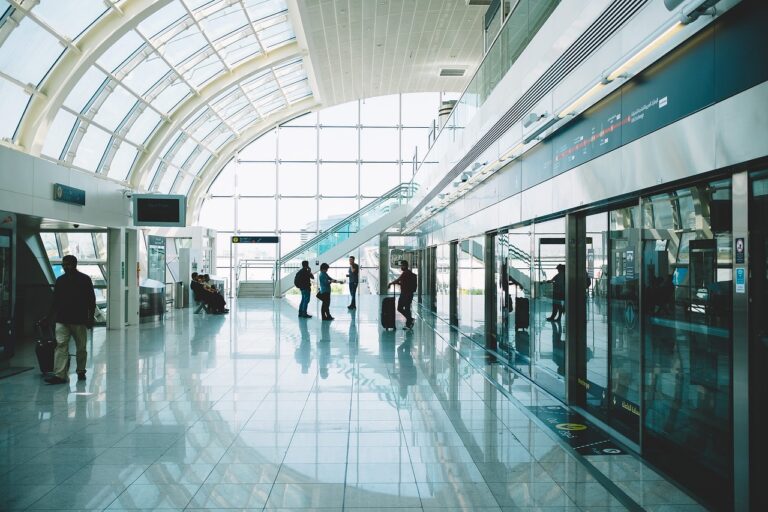The evolving technology landscape is reshaping long-standing trends and creating new paradigms in airport security operations. The European border and coast guard agency, Frontex, has published a new report focusing on the emerging technologies that are expected to have an impact on border security, including at airport checkpoints.
In a recent opinion piece for Passenger Terminal Today, Geoff Warr explained how airports have become increasingly reliant on artificial intelligence (AI), using the technology to detect undiscovered risks, identify existing problems, enable terrorist attacks to be foreseen, ease passenger flow and generally enhance overall security at airports.
Tension amid myriad benefits
AI is also being integrated into biometrics and facial recognition for improved performance. Frontex’s report notes that such technologies have the potential to enhance surveillance capabilities and reduce time spent on identifying fraudulent documents and identities. However, despite growing trust in traveler biometrics over the past decade, new privacy concerns around AI and detection technologies have emerged, and the European Commission has amended the AI Act to regulate facial recognition technologies more comprehensively, including data interoperability and storage restrictions. There is inevitably a tension between innovation and regulation, and industry and regulators must find a balance between increasing security while maintaining privacy. Frontex says computer scientists are working on methods that mitigate bias to avoid skewed results from AI, which is likely to be an ongoing process rather than a one-time fix.
On the flip side, AI can provide solutions to traveler concerns and improve their journey through airport security. For example, the Transportation Security Administration (TSA) and the industry developed an AI algorithm to reduce the number of pat-downs required as a result of alarm triggers by existing advanced imaging technology (AIT) passenger scanners. The algorithm was developed primarily to address alarms caused by transgender passengers but the number of pat-downs has reduced for all passengers at airports using the updated scanners.
There are benefits for the security workforce too. As Alex Grant previously reported for Passenger Terminal Today, increased use of AI could free up screeners from repetitive and monotonous tasks, enabling them to focus on risk and alarm resolution.
In addition to the benefits AI can bring to passenger screening operations, it can play a part in enhancing baggage screening. Steve Karoly, former acting assistant administrator for the TSA Office of Requirements and Capabilities Analysis and now executive vice president at K2 Security Screening Group, told us about the agency’s latest research in this area.
“Progress is being made in the development of AI-based algorithms for computed tomography (CT) screening technologies. TSA is expected to pilot this new algorithm, Image on Alarm, in the upcoming calendar year. If successful, TSA will conduct certification testing shortly thereafter with the hope of deploying this capability nationwide.”
Karoly explained how the technology helps detect suspicious items, and said that only those checked bags that have or possibly have a threat object get displayed to the transportation security officer (TSO) for review. “This capability will dramatically improve checkpoint efficiency given that only a small percentage of carry-on bags would be flagged for TSO intervention,” he said.
Elsewhere, Schiphol has also been testing an AI baggage screening system developed by Pangiam and Google Cloud, which is designed to reduce image analysis time.
AI has the potential to help further. In its future technologies report, Frontex notes that AI-powered solutions could also help combat human trafficking. It says that AI avatar technology can help maintain the anonymity of victims during human trafficking investigation interviews by giving them an entirely new AI-generated face and voice. In addition, the use of AI-powered analytics guided by computer vision can aid in processing identification documents at security checkpoints.
Beyond AI
Although the emphasis is very much on AI at present, which is no surprise given the enormous potential and the need to mitigate risks, other emerging technologies can also be harnessed to improve security operations at airports. Frontex has found, for example, that extended reality (XR) and metaverse technologies can also offer direct benefits, such as enhanced training and preparedness, reduced language barriers and streamlined data handling. In the near term, these technologies could bring higher-resolution, better-performing displays as well as sensors that can more accurately track movements. Additionally, the agency believes XR Cloud will offer a cloud-based medium that will act as a digital copy of the real world, where developers and non-developers alike can build AR experiences and applications using frameworks rather than starting from scratch. This could accelerate product development and offer additional testing scenarios without compromising the passenger experience or airport operations.
However, Frontex warns that governments and businesses will need to stay engaged and abreast of changes in the XR ecosystem so that they can adapt their practices accordingly and transparently to ensure ongoing compliance and public trust in their use of XR technologies. As with AI, Frontex adds that XR and the metaverse require cybersecurity safeguards to prevent data breaches and cyberattacks.
Smart glasses or augmented reality (AR) glasses have been used at airports. For example, ground crew at Singapore Changi Airport began using smart glasses in 2017 to digitalize ramp handling operations, and in 2018 several US airports introduced smart glasses to assist passengers with visual impairments. However, these technologies have yet to fulfill their potential.
In terms of security applications, Frontex says AR glasses can enhance operational processes by displaying documentation directly in a security officer or border guard’s line of vision. AR glasses can also use facial recognition technology, voice print and backend databases to compare individuals at the border with watchlists of known criminals, terrorists or other persons of interest. Furthermore, AR glasses could aid in instantaneous identification and enable officers to take appropriate action and prevent the entry of potential threats if matches are found.
The right balance
Matching emerging technologies to airport security processes presents a dynamic, exciting landscape. Some restraint is required, however, to ensure adoption occurs at the right pace to satisfy government authorities, airport operators and the traveling public, without courting unnecessary risk. As Frontex’s report states, “To remain responsive in a changing environment, particularly when there are security implications, it is beneficial to utilize a structured sensing process paired with advanced aggregation methods.”
Help and guidance are available for emerging tech developers to ensure safe and secure adoption and implementation. On November 26, for example, the US Department of Homeland Security’s Cybersecurity and Infrastructure Security Agency and the UK’s National Cyber Security Centre released Guidelines for Secure AI System Development to help developers of any systems that use AI make informed cybersecurity decisions at every stage of the development process. The guidelines are broken down into four key areas within the AI system development lifecycle: secure design, secure development, secure deployment, and secure operation and maintenance.
Such guidance will help the industry strike the right balance to achieve successful use and acceptance of today’s – and tomorrow’s – technology in airport operations.

